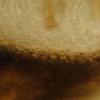
21-12-2025 21:32
Pol DebaenstHello, Garden, Burgweg 19, Veurne, BelgiumOn 10/1

22-12-2025 23:38
Patrice TANCHAUDBonsoir, récolte sur un mur en pierre, apothéci

21-12-2025 09:32
Hello.A tiny ascomycete found embedded in wood in

22-12-2025 00:47
Patrice TANCHAUDBonsoir, récolte à proximité du milieu dunaire

21-12-2025 21:40
Isabelle CharissouBonjour, j'aimerais connaitre les références de

21-12-2025 21:31
Pol DebaenstHello, Garden, Burgweg 19, Veurne, BelgiumOn 10/1

21-12-2025 21:31
Pol DebaenstHello, Garden, Burgweg 19, Veurne, BelgiumOn 10/1

20-12-2025 23:08
Patrice TANCHAUDBonsoir, récolte sur sol sablonneux dans l'arri�
Salut à tous,
I am trying (and mostly failing!) to identify some ascomycetes in a floodplain in the South of England - I wonder if anyone can help me with this species on a dead Phalaris culm?
Collected 24/04/2014
Perithecia: Mostly immersed (some almost erumpant), 0.5 - 0.6mm diam. All ostioles rounded
Asci: Bitunicate, 8-spored
Ascospores: 5-Septate, brown and distinctly roughened on release, 26.8 - 30.6 x 6.1 - 7.2 µm. No sheath observed in indian ink
Pseudoparaphyses: around 2 µm diam, mostly unbranched, septate, without conspicuous droplets
There was an anamorph nearby which reminded me of Stagonospora (?)
I've tried looking in 'the usual' genera that I associate with grasses in this habitat (Massarina, Phaeosphaeria, Lophiotrema, Massariosphaeria etc.) but with little luck yet - Can anyone make any suggestions or at least point me in the right direction?
Amitiés,
Nick

my first thought was that the species belongs in the group of Phaeosphaeria luctuosa, which has a Stagonospora anamorph. This anamorph should have longer conidia as shwon on your third picture. The spores of Ph. luctuosa are furthermore described as being smooth (Leuchtmann 1984).
I do not know your species, but I have collected and studied many of these small dots on grasses and herbs. I do not wish to disturb you with sending another species :D
regards,
björn
Hi Björn,
Thanks, I also thought of Phaeosphaeria at first, but was thrown off course by the spores which seemed quite lophiostomoid when immature (sorry for the poor photo).
I went back over Shoemaker & Babcock and didn't find anything that fit, though Montagnula subsuperficialis seemed very close. The authors mentioned a similar species which seems a good solution for my problem: Montagnula rhodophaea.
What do you think?
I noted that Leuchtman only described microconidia as an anamorph for this species, so perhaps my Stagonospora belongs to another fungus......
I have almost exhausted the specimen, so I would probably be wasting your time by sending this one - If I collect it again I'll post it.
Best wishes,
Nick

I think you are right, finely dotted spores are typical for Montagnula species, but also for some Leptosphaeria and Phaeosphaeria, so we have to look for hyphal structures on the surface, something like a "Stroma" or a Clypeus. A section through the pseudothecia would also help.
regards,
björn
Hi Björn,
There are indeed patches of dark stromatic tissue around the pseudothecia, and surface of the host (under the epidermis) is black with fungal cells. It seem there is also a golden-red discolouration of the substrate which I think Leuchtmann describes (my German isn't very good and Google Translate doesn't help much sometimes!).
The pseudothecium wall seems OK too - I think I will label this one as M.rhodophaea unless anyone disagrees....
Best wishes,
Nick






